Behavioral impairments in rats with chronic epilepsy suggest comorbidity between epilepsy and attention deficit/hyperactivity disorder
- PMID: 24262783
- PMCID: PMC3946735
- DOI: 10.1016/j.yebeh.2013.10.004
Behavioral impairments in rats with chronic epilepsy suggest comorbidity between epilepsy and attention deficit/hyperactivity disorder
Abstract
Attention deficit/hyperactivity disorder (ADHD) is encountered among patients with epilepsy at a significantly higher rate than in the general population. Mechanisms of epilepsy-ADHD comorbidity remain largely unknown. We investigated whether a model of chronic epilepsy in rats produces signs of ADHD, and thus, whether it can be used for studying mechanisms of this comorbidity. Epilepsy was induced in male Wistar rats via pilocarpine status epilepticus. Half of the animals exhibited chronic ADHD-like abnormalities, particularly increased impulsivity and diminished attention in the lateralized reaction-time task. These impairments correlated with the suppressed noradrenergic transmission in locus coeruleus outputs. The other half of animals exhibited depressive behavior in the forced swimming test congruently with the diminished serotonergic transmission in raphe nucleus outputs. Attention deficit/hyperactivity disorder and depressive behavior appeared mutually exclusive. Therefore, the pilocarpine model of epilepsy affords a system for reproducing and studying mechanisms of comorbidity between epilepsy and both ADHD and/or depression.
Keywords: 5-HT; ADHD; Attention deficit/hyperactivity disorder; Depression; EPMT; Epilepsy; FCV; FST; LC; LRTT; Lateralized reaction-time task; NE; Norepinephrine; PFC; RN; SE; Serotonin; TLE; attention deficit/hyperactivity disorder; elevated plus maze test; fast cyclic voltammetry; forced swimming test; lateralized reaction-time task; locus coeruleus; norepinephrine; prefrontal cortex; raphe nucleus; serotonin; status epilepticus; temporal lobe epilepsy.
© 2013.
Conflict of interest statement
Dr. Jentsch and Dr. Griesbach report receiving research support from NIH. Dr. Sankar reports receiving research support from Pfizer and consultancy and speaker bureau fees from UCB, Lundbeck, Sunovian, Upsher-Smith and Supernus. Dr. Dr. Mazarati reports receiving research support from the NIH and the Today and Tomorrow Children’s Fund.
Figures
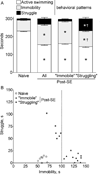
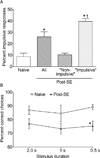
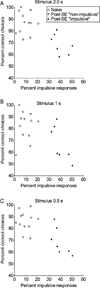
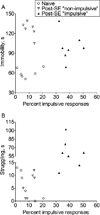

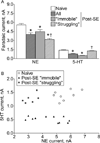
Similar articles
-
Galanin contributes to monoaminergic dysfunction and to dependent neurobehavioral comorbidities of epilepsy.Exp Neurol. 2017 Mar;289:64-72. doi: 10.1016/j.expneurol.2016.12.008. Epub 2016 Dec 22. Exp Neurol. 2017. PMID: 28013000 Free PMC article.
-
Effects of selective serotonin and norepinephrine reuptake inhibitors on depressive- and impulsive-like behaviors and on monoamine transmission in experimental temporal lobe epilepsy.Epilepsia. 2016 Mar;57(3):506-15. doi: 10.1111/epi.13321. Epub 2016 Jan 27. Epilepsia. 2016. PMID: 26813337 Free PMC article.
-
Inherent vulnerabilities in monoaminergic pathways predict the emergence of depressive impairments in an animal model of chronic epilepsy.Epilepsia. 2017 Aug;58(8):e116-e121. doi: 10.1111/epi.13822. Epub 2017 Jun 9. Epilepsia. 2017. PMID: 28597913 Free PMC article.
-
[Attention deficit hyperactivity disorder and epilepsy in childhood].Rev Neurol. 2012 Feb 29;54 Suppl 1:S89-93. Rev Neurol. 2012. PMID: 22374777 Review. Spanish.
-
Transcutaneous auricular vagus nerve stimulation as a potential therapy for attention deficit hyperactivity disorder: modulation of the noradrenergic pathway in the prefrontal lobe.Front Neurosci. 2024 Dec 4;18:1494272. doi: 10.3389/fnins.2024.1494272. eCollection 2024. Front Neurosci. 2024. PMID: 39697776 Free PMC article. Review.
Cited by
-
Protective Role of L-3-n-Butylphthalide in Cognitive Function and Dysthymic Disorders in Mouse With Chronic Epilepsy.Front Pharmacol. 2018 Jul 11;9:734. doi: 10.3389/fphar.2018.00734. eCollection 2018. Front Pharmacol. 2018. PMID: 30050437 Free PMC article.
-
The association between ADHD and physical health: a co-twin control study.Sci Rep. 2020 Dec 28;10(1):22388. doi: 10.1038/s41598-020-78627-1. Sci Rep. 2020. PMID: 33372183 Free PMC article. Clinical Trial.
-
The challenges and innovations for therapy in children with epilepsy.Nat Rev Neurol. 2014 May;10(5):249-60. doi: 10.1038/nrneurol.2014.58. Epub 2014 Apr 8. Nat Rev Neurol. 2014. PMID: 24709890 Free PMC article. Review.
-
Impaired Response to Mismatch Novelty in the Li2+-Pilocarpine Rat Model of TLE: Correlation with Hippocampal Monoaminergic Inputs.Biomedicines. 2024 Mar 12;12(3):631. doi: 10.3390/biomedicines12030631. Biomedicines. 2024. PMID: 38540244 Free PMC article.
-
Cognitive comorbidities in the rat pilocarpine model of epilepsy.Front Neurol. 2024 May 30;15:1392977. doi: 10.3389/fneur.2024.1392977. eCollection 2024. Front Neurol. 2024. PMID: 38872822 Free PMC article.
References
-
- Schubert R. Attention deficit disorder and epilepsy. Pediatric neurology. 2005;32:1–10. - PubMed
-
- Parisi P, Moavero R, Verrotti A, Curatolo P. Attention deficit hyperactivity disorder in children with epilepsy. Brain & development. 2010;32:10–16. - PubMed
-
- Kaufmann R, Goldberg-Stern H, Shuper A. Attention-deficit disorders and epilepsy in childhood: incidence, causative relations and treatment possibilities. Journal of child neurology. 2009;24:727–733. - PubMed
-
- Kanner AM. The use of psychotropic drugs in epilepsy: what every neurologist should know. Seminars in neurology. 2008;28:379–388. - PubMed
-
- Hesdorffer DC, Ludvigsson P, Olafsson E, Gudmundsson G, Kjartansson O, Hauser WA. ADHD as a risk factor for incident unprovoked seizures and epilepsy in children. Archives of general psychiatry. 2004;61:731–736. - PubMed
Publication types
MeSH terms
Substances
Grants and funding
LinkOut - more resources
Full Text Sources
Other Literature Sources
Medical
Miscellaneous

